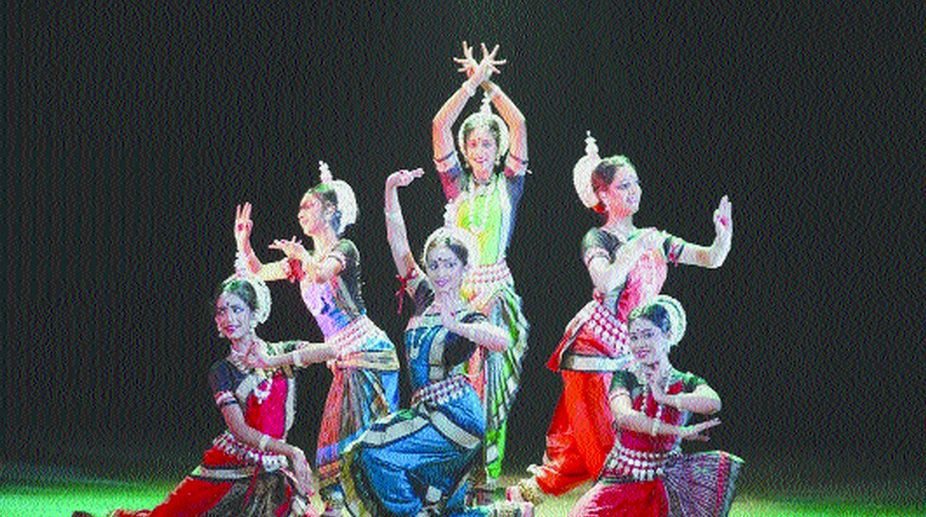Best of both worlds

Matharam by Arupa Chatterjee’s disciples (PHOTO: SNS)
A leading disciple of Odissi Guru Ratikant Mohapatra, Aparupa Chatterjee has a PhD in “How Performing Arts may be used in International Development”. She is a repertory dancer of Odisha’s Srjan and took Odissi dance to Texas in the US in 2007 — Chatterjee founded the International Institute for Culture and Performing Arts Development at Texas A&M University and is the organiser of the North American Odissi Convention, which functions on a non-profit basis.
With extensive research on the techniques and aesthetics of Odissi, she has created a niche for herself in choreographing through performing and training dancers. She is a recipient of the prestigious Regents Fellowship, Indo-American Arts Council grant and National Scholarship from the Government of India,
Recently she initiated the sixth Kelucharan Guna Keertanam in a grand function at Gyan Manch in Kolkata, where she brought together Guruji’s disciples to the art lovers of the city, with a view to start a cultural exchange of dancers and artists on an international scale.
Chatterjee’s student from Texas commenced the performance eulogising Krishna with the memorable composition, Swagatham Krishna Sharanagatham Krishna, in raag bhupali and taal khemta by Yesudas in Carnatic style, choreographed by Guru Ratikant Mohapatra. The dance described Krishna as the one whose fragrance is that of divine flowers.
The dance Bakra tunda mahakaya in raag misra shuddha and taal ektaali, which followed, was about Ganesha, the dispeller of all obstacles. Rajib Bhattacharya, a direct disciple of Guru Ratikant, performed it with élan. Clad in red costumes, Bhattacharya’s disciples presented a judiciously tailored choreographic piece Nav Durga depicting the nine manifestations of the Devi.
The piece de resistance of the evening was Varsha — an abhinaya choreographed by Guru Ratikant Mohapatra and performed by, Rajashree Praharaj, a celebrated repertory dancer of Srjan. Praharaj made her statement about the many faceted quality of rain with complete mastery over technique.
Divya Srinivasa, a talented disciple of Chatterjee, made her mark with Jaya Mahesha in raag shivaranjani and taal ektali. The physical descriptions of Shiva with the Ganga flowing from his locks and all else was rendered to satisfaction. The philosophy that he is the creator of the universe and is the lord of dance is a rather difficult concept to emote, which would come with age and maturity. Vande Mataram by Bankim Chandra Chattopadhayay, describing the ravishing beauty of the country with its flowing rivers and mountain ranges, was a sensitively choreographed piece, which combined the beauty of the lyric with that of Odissi. It reflected the awareness of the performers and showcased the rich heritage that they have inherited. This piece was one of the best performances of the evening by the Odissi Dance Company members, who are growing up in a distant culture. The choreography bears the stamp of Guru Kelucharan Mohapatra. The music arrangements were by Ramesh Chandra Das and Bijay Kumar Jena
Chatterjee’s student, Divya Chaudhary, performed Hamsadhwani pallavi, a pure dance piece set to ektaali. The piece, choreographed by Guru Kelucharan Mohapatra, composed by Pandit Bhuvneshwar Misra, was in raga hamsadhwani. The elaborations and expositions were graceful. On the other hand, the lyrical movements, supported by intricate patterns were of exceptional beauty, creating a beautiful tapestry of rhythm, music and movement. It was one of the most graceful and charming performances of the evening.
Madhulita Mohapatra, an Odissi dancer who has made Bangalore her home, presented the abhinaya piece, Harirabhisarati on the popular ashtapadi, Madhave ma kuru manini manam aye from Geeta Govinda. Here the sakhi earnestly requests Radha to go to her beloved Krishna leaving her hurt feelings behind. In the sequence, harim avalokaya saphalaya nayane, the dancer showed her sakhi watching Krishna lying on a bed of lotus petals and getting the true realisation of the Lord in his ten incarnated form. With limited movement of the body and more through the language of her eyes and mukhabhinaya (facial acting), Mohapatra emoted superbly.
The high point in Chatterjee’s dance career was her choreographic work on Vithala or Vishnu. The devotees of Pandurange, another name for Vithala the merciful one, entreat him to redeem them from the cycle of birth and rebirth. This beautiful lyric is of the abhang genre, which is a form of devotional poetry taken from the works of Sant Namdev, a famous poet of Maharashtra. It was an experimental neo-classical Odissi piece inspired by her guru Ratikant.
Vishnu or Lord Vithala is imagined to be Chaturbhuja or one who has four hands. He holds a conch shell and a chakra. An invocation by the Bhaktas for Lord Pandurange Vithala, Namdev portrays him as a mother, as Kshrabdi, Nivasini and Jagadambe. Through the movements of the dancers, the meanings of the lyrics were highlighted. The aim of this piece was to promote global peace. It was performed by the Odissi Dance Company — Divya Chowdhary, Divya Srinivasa, Yashaswini Raghuram, Swati Yarlagadda and Ramyani Roy. Music Composition was by Pandit OS Arun.
The evening of dance was interwoven with performances by both India based dancers as well as performers from the US. In keeping with the spirit of coming together on a common platform, Rajneeta Mehra, a Kolkata-based dancer, performed Yugmadwanda and Megh Pallavi. The choreography was by Guru Ratikant Mohapatra while the music was composed by Pandit Raghunath Panigrahi.
The concluding performance was Batu, a pure dance piece, choreographed in raag bhopali and taal ektaali by Guru Kelucharan Mohapatra. It was performed by Ramyani Roy of the Odissi Dance Company, who is based in Houston, Texas and Anindita Ghosh of Chhanda Manjari from Kolkata.
Advertisement
Advertisement
Advertisement
